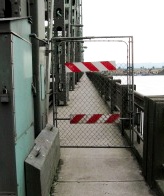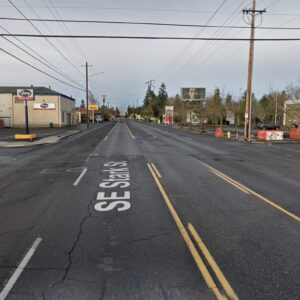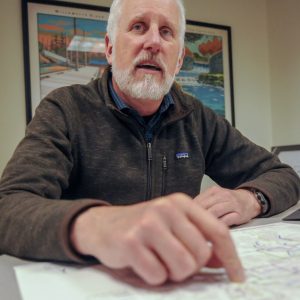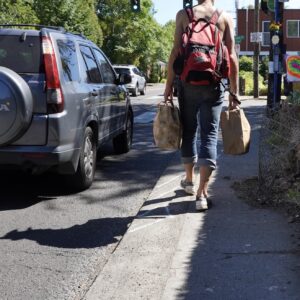
(Photo: Todd Boulanger)
Yesterday we received information from a reader that the gates on the I-5 bridge sidewalk had malfunctioned, staying closed for over 30 minutes on Wednesday night and blocking access across the bridge for people on bikes and on foot.
That reader, Todd Boulanger, has since been contacted by Kimberly Dinwiddie at ODOT Community Affairs. Dinwiddie says the gate closure wasn’t a malfunction, but that bridge engineers decided to keep them closed due to a passing vessel and traffic on a railroad bridge downstream.
Read more about ODOT’s protocol for bridge closures and what happened Wednesday in Dinwiddie’s follow-up below:
Thanks for writing Todd. I am sorry you and others were delayed while traveling over the Interstate Bridge yesterday.
Please allow me to give a brief explanation of what happened last night (it wasn’t a gate malfunction) and our protocols for closing the gates prior to a bridge lift.
Yesterday around 6 p.m., a vessel called to the Interstate Bridge requesting a bridge lift. According to maritime law, the vessel has right-of-way and all traffic on the bridge must yield.
When a bridge lift is requested, the first thing we do is close the gates to the pedestrian/bicycle paths. This is for the safety of path users. We want to allow those crossing the bridge to finish their trip and prevent people from entering the path and risk getting caught mid-span as we start to lift the bridge.
We close the gates to vehicle traffic after closing the pedestrian/bicycle gates, shortly before we begin the bridge lift. Obviously, vehicles traveling across the bridge at 50 MPH get across the bridge quickly and do not run the risk of getting stuck mid-span as we begin the bridge lift.
Last night, the bridge lift was delayed for nearly 30-minutes due to traffic on the railroad bridge downstream. At the time, our bridge tenders did not know the length of time the bridge lift was going to be delayed. In anticipation of the bridge lift, the gates to the paths remained closed as you and others experienced.
However, our bridge tender exercised judgment and opened the pedestrian gates on the southbound side three times during the 30-minute bridge lift delay to allow bicycle and pedestrian traffic to cross the bridge.
Again, we apologize for the inconvenience caused by bridge lifts. Right now, the water is quite high on the Columbia River and we will continue to experience a high number of bridge lifts while the water remains
high.Vessels traveling the Columbia do not always have the right-of-way to the Interstate Bridge. Bridge lifts are restricted at these times: Monday through Friday from 6:30 a.m. to 9 a.m. and 2:30 p.m. to 6 p.m., unless it’s a federal holiday. Federal holidays are like weekends; federal law requires us to do bridge lifts whenever they are requested.
Kimberly Dinwiddie
ODOT Community Affairs
Now you know.







Thanks for reading.
BikePortland has served this community with independent community journalism since 2005. We rely on subscriptions from readers like you to survive. Your financial support is vital in keeping this valuable resource alive and well.
Please subscribe today to strengthen and expand our work.
Gosh. I’m so stinking greatful for BikePortland. Your ability to follow up even on relatively minor news items is awe inspiring. Thank you for all your dedication.
It really is too bad that they didn’t spend the money that they have wasted planning the CRC freeway expansion on fixing the seismic problems on the rail bridge. The proposed upgrade to the rail bridge, which I think has been languishing without funding for over a decade now would eliminate 90% of the bridge lifts by allowing river traffic a straighter shot through the two bridges.
They can’t. The CRC is an ODOT project, owned by the state and overseen by FHWA. The railroad bridge is owned by Burlington Northern Santa Fe Railroad (BNSF) and overseen by the FRA. That’s like asking why the City of Portland isn’t paying to remodel the Interstate & Lombard Fred Meyer store.
Now, if FRA, FHWA and the Coast Guard *required* BNSF to pay to align their bridge, that would be another matter entirely.
Correction – an ODOT and WashDOT project, and overseen by both states and the FHWA.
Here is a good explanation for why the CRC is the “Dog in the Manger” preventing a fix to the railroad bridge:
http://smarterbridge.org/?q=node/20
The Columbia River Towboat Association worked hard to get Federal funds for fixing the railroad bridge, and the Coast Guard said they would help, if Oregon’s delegation came up with the money. Instead, the DOT’s pushed for the CRC “solution.”
I’m sure BNSF wouldn’t complain if ODOT and WSDOT wanted to fund improvements to their bridge. They’ve been more than happy to use the state funding for rail improvements in the past, and will be doing more soon:
http://www.wsdot.wa.gov/Projects/Rail/
Here’s a short (just over a minute) video I did that illustrates some of the issues surrounding these bridges: http://www.vimeo.com/21585967.
It’s a clip from the longer CRC video linked to in my user name.
I sat in southbound traffic during this exact bridge lift on the way to bike polo.
Really not an unusual amount of time to sit there, has been longer in the past. I could see that the southbound side was going up way slower than the northbound side, which is also typical.
The real problem is the gate should be closer to the girders when closed. And the gap where the two bridge pieces come together does not always mesh up.
In conclusion, this bridge sucks, plese build me a new one soon.
Sure you can have a new bridge – just pay a $5 toll. Then I’ll be happy to not oppose the bridge, because I don’t want to pay for it.
I’m down with making any freeway closed to bicycles a turnpike.
What is the fine for jumping onto the freeway with your bike and going around the gate?
I don’t care if Thomas the Train engine owns the Rail bridge. The government can easily pass new laws. If we fixed that rail bridge we would have one less reason to build the 5 miles of CRC freeway and 6 interchanges. Does anyone know what it would cost to fix the rail bridge to lift in the center? That would mean 95% less bridge lifts disrupting interstate 5.
Joe,
I already provided that information above, in response to Matt Picio’s statements, but here it is again: http://smarterbridge.org/?q=node/20
Please read the entire context, but in short, the number was $42 million in year 2000 dollars.
BTW, If Blumenauer, Merkley and Wyden had any guts or brains they would pass laws to let us fix the railroad bridge and save the $10 billion on the CRC freeway. Washington lawmakers love the CRC because most of the 5 miles is in their state, with much of the cost paid by Oregon.
Um, okay. But ODOT’s response brings on an qbvious question —
* If the bridge operator opened the southbound gates 3 times during the 30 minute delay, why didn’t he/she open the nortbound gates as well?
Seems that if there’s a policy in place to let folks through, that there should also be a policy in place to take 5 seconds and scan the bridge cameras and see if bike/ped traffic is queuing up on the other side as well.
It would be a simple ask, of ODOT, for Todd or anyone else, to request that bridge tenders look for stopped traffic on both bridges when the path gates are closed for an extended period of time.
Ted Buehler
If bikes must stop, so should motorists. We subsidize motorists, after all.